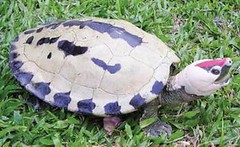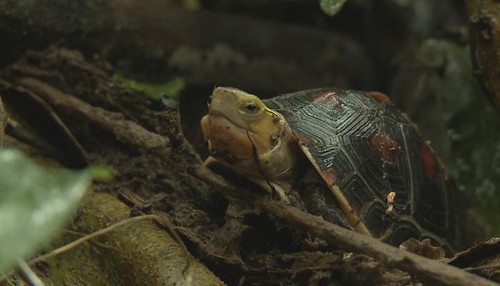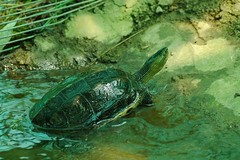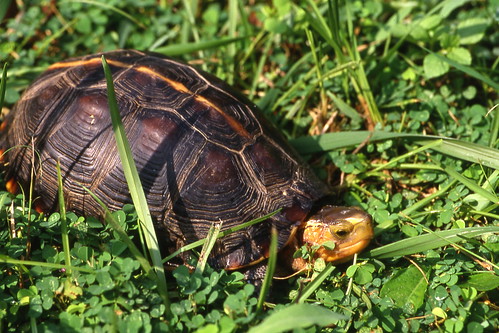 國際野生物保育協會(Wildlife Conservation Society,WCS)11日宣布,他們將發起行動,負起保育某些世界上最瀕危的陸龜及淡水龜的責任。
國際野生物保育協會(Wildlife Conservation Society,WCS)11日宣布,他們將發起行動,負起保育某些世界上最瀕危的陸龜及淡水龜的責任。
這些龜類遭到人們大量的收集、買賣、食用和入藥,也因此被推向滅絕。此外,牠們的棲息地亦遭到分割、破壞、開發和污染。
設在紐約布朗克斯動物園的國際野生物保育協會已經發展出新的策略,以防止至少一半瀕危龜類物種遭到滅絕。這份瀕危龜類物種清單是由國際野生物保育協會和其他團體在2011年所提出,其中列舉了25種世界上最瀕危的海龜和陸龜。
國際野生物保育協會表示,四個極度瀕危的物種將優先受到保護,以減少因商業捕捉及遭魚網纏繞而死的數量。
 這四個物種分別是:緬甸星龜(Geochelone platynota)、緬甸稜背龜(Batagur trivittata)、南方巨河龜(Batagur affinis)與中美洲河龜(Dermatemys mawii)。
這四個物種分別是:緬甸星龜(Geochelone platynota)、緬甸稜背龜(Batagur trivittata)、南方巨河龜(Batagur affinis)與中美洲河龜(Dermatemys mawii)。
國際野生物保育協會希望藉由與政府合作來保護這些瀕危龜類,讓柬埔寨、中國、哥倫比亞、厄瓜多爾、瓜地馬拉、印尼、緬甸和越南等龜類多樣性高的國家能迅速響應。
為了確保瀕危龜類的生存,國際野生物保育協會將利用其四個動物園和水族館(中央公園動物園、皇后動物園、展望公園動物園與紐約水族館),以及它的全球野生物健康計劃與保育計畫。
國際野生物保育協會打算繁殖並將一些物種重新引入牠們的原棲地,並透過現地作業保護其他物種。研究人員將建立存續種群(assurance colonies)並圈養個體,以確保遺傳多樣性的完整性。
國際野生物保育協會已開始在美國進行其他適合於動物園繁殖的龜類物種復育工作。這些烏龜個體在孵化後,會先在布朗士動物園通過檢疫,再送至原產國家進行野放。
 最後,國際野生物保育協會打算在紐約圈養、繁殖並孵育這些瀕危龜類,以補充尚存於野外的族群數量。星點龜(Cyclemys guttata)、卡羅萊納箱龜(Terrapene carolina)與木紋龜(Glyptemys insculpta)等瀕危物種的戶外隔離區已經設立於布朗克斯動物園中。
最後,國際野生物保育協會打算在紐約圈養、繁殖並孵育這些瀕危龜類,以補充尚存於野外的族群數量。星點龜(Cyclemys guttata)、卡羅萊納箱龜(Terrapene carolina)與木紋龜(Glyptemys insculpta)等瀕危物種的戶外隔離區已經設立於布朗克斯動物園中。
為了推動全世界的龜類保育行動,國際野生物保育協會要求美國國會全力支援美國漁業與野生物局的「野生物無國界計畫」(Wildlife Without Borders Program)。漁業與野生物局的「極度瀕危動物保育基金」(Critically Endangered Animals Conservation Fund)將用於全世界陸龜與淡水龜類的保育工作。
除了陸龜與淡水龜類外,國際野生物保育協會仍將繼續為保育尼加拉瓜、加彭、蘇拉威西與馬達加斯加等地的海龜而努力。
The Wildlife Conservation Society today announced that it would "take direct responsibility" for the survival of some of the world's most endangered tortoises and freshwater turtles.
So many of these animals are being collected, traded, eaten and used for medicine that they are being pushed into extinction. In addition, their habitats are being fragmented, destroyed, developed, and polluted.
Based at New York's Bronx Zoo, the Wildlife Conservation Society has developed a new strategy to prevent the extinction of at least half of the species in a 2011 report by WCS and other groups that lists the world's 25 most endangered turtles and tortoises.
Four top-priority Critically Endangered species will be protected first, says WCS, which plans to reduce the numbers of turtles caught for the commercial trade and reduce the numbers of aquatic turtles that die by drowning in fishing nets.
The four species are: the Burmese starred tortoise, Geochelone platynota, the Burmese roofed turtle, Batagur trivittata, the Southern River terrapin, Batagur affinis, and the Central American river turtle, Dermatemys mawii.
The organization plans to safeguard the endangered turtles by working with governments to react rapidly in nations that are centers of turtle diversity, such as Cambodia, China, Colombia, Ecuador, Guatemala, Indonesia, Myanmar (Burma), and Vietnam.
To ensure survival of the endangered turtles and tortoises, WCS will use its four zoos and aquarium, its global wildlife health program, and its conservation field programs.
WCS will breed and reintroduce some species and and protect others with field work. For another group of species, the scientists will develop assurance colonies, captive groups of animals maintained so that no genetic diversity is lost.
WCS has plans to begin recovery of other species suited for zoo breeding programs within the United States. Turtles hatched through this effort will be quarantined at a biosecure facility at the Bronx Zoo, then transferred to holding facilities in their range countries to begin reintroduction programs.
Finally, WCS plans to establish a captive breeding and head-starting program for imperiled turtle species native to New York State to supplement remaining wild populations. Off-exhibit, outdoor enclosures will be constructed at the Bronx Zoo for several species, including the spotted turtle, Cyclemys gutatta, Eastern box turtle, Carolina terrapene, and wood turtle, Glyptemys insculpta.
To help promote worldwide turtle conservation, WCS is asking Congress to fully fund the U.S. Fish and Wildlife Service's Wildlife Without Borders Program, whose Critically Endangered Animals Conservation Fund supports several freshwater turtle and tortoise conservation projects around the world.
In addition to its efforts to conserve terrestrial and freshwater turtles, WCS continues conservation efforts for on sea turtles in Nicaragua, Gabon, Sulawesi, and Madagascar.







